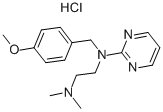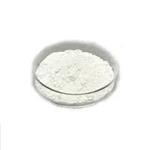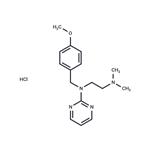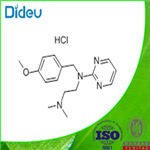White, crystalline powder; faint odor. Very soluble in water; freely soluble
in alcohol and chloroform; practically insoluble in
ether and benzene; pH 5.0–6.0 (2% solution).
Neohetramine,Warner Lambert,US,1948
Medicine (antihistamine).
ChEBI: Thonzylamine hydrochloride is a member of methoxybenzenes.
54 g of 2-(p-methoxybenzyl)aminopyrimidine and 12.0 g of sodamide were
suspended in 250 cc of toluene and were refluxed for 31 hours. To the thus
prepared sodium salt of 2-(p-methoxybenzyl)aminopyrimidine, 28.1 g of
dimethylaminoethyl chloride were added and refluxed under continuous
stirring for 26 hours. After cooling, the reaction mixture was extracted with
dilute hydrochloric acid at about pH 5.0, removing the product thus formed
containing only very little of the unreacted 2-(p_x0002_methoxybenzyl)aminopyrimidine. This solution was then made alkaline to
liberate the free base of the product, which was extracted with ether. The
ether solution was evaporated and the residue vacuum distilled. The product,
2-(p-methoxybenzyl-dimethylaminoethyl)aminopyrimidine forms an oily liquid,
boiling point 185°C to 187°C at 2.2 mm.
Thonzylamine hydrochloride,2-[[2-(dimethylamino)-ethyl](p-methoxybenzyl)amino]pyrimidine hydrochloride, is a white crystallinepowder soluble in water (1:1), in alcohol (1:6), and in chloroform(1:4). A 2% aqueous solution has a pH of 5.5. It is similar in activity to tripelennamine but is claimed to be lesstoxic. The usual dose is 50 mg taken up to 4 times daily. Itis available in certain combination products.
White crystalline powder with a faint odor . pH: 5.1-5.7 (2 % aqueous solution).
thonzylamine hydrochloride behaves as a weak organic acid. Materials in this group are generally soluble in water. The resulting solutions contain moderate concentrations of hydrogen ions and have pH's of less than 7.0. They react as acids to neutralize bases. These neutralizations generate heat, but less or far less than is generated by neutralization of inorganic acids, inorganic oxoacids, and carboxylic acid. They usually do not react as either oxidizing agents or reducing agents but such behavior is not impossible.
SYMPTOMS: Symptoms of exposure to thonzylamine hydrochloride may include drowsiness, lethargy, fatigue, hypnosis, coma, vertigo, ataxia, tinnitus, blurred vision, tremors, anxiety, insomnia, excitement, hallucinations, delirium, convulsions, dry mouth, anorexia, nausea, vomiting, abdominal distress, constipation, diarrhea, central nervous system depression, gastrointestinal reactions, respiratory arrest and circulatory collapse.
Flash point data for thonzylamine hydrochloride are not available. thonzylamine hydrochloride is probably combustible.



